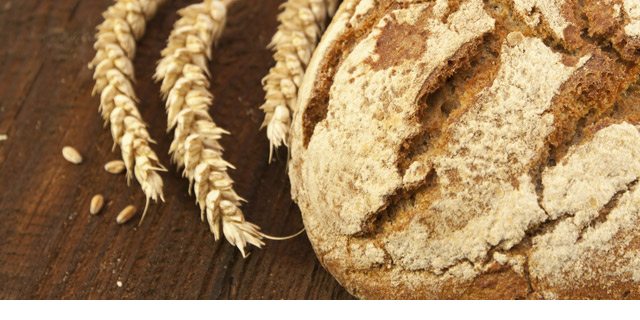
Whole Wheat vs. Hole Wheat
Ingredients found in fresh ground whole wheat flour and why they matter
Wheat structure
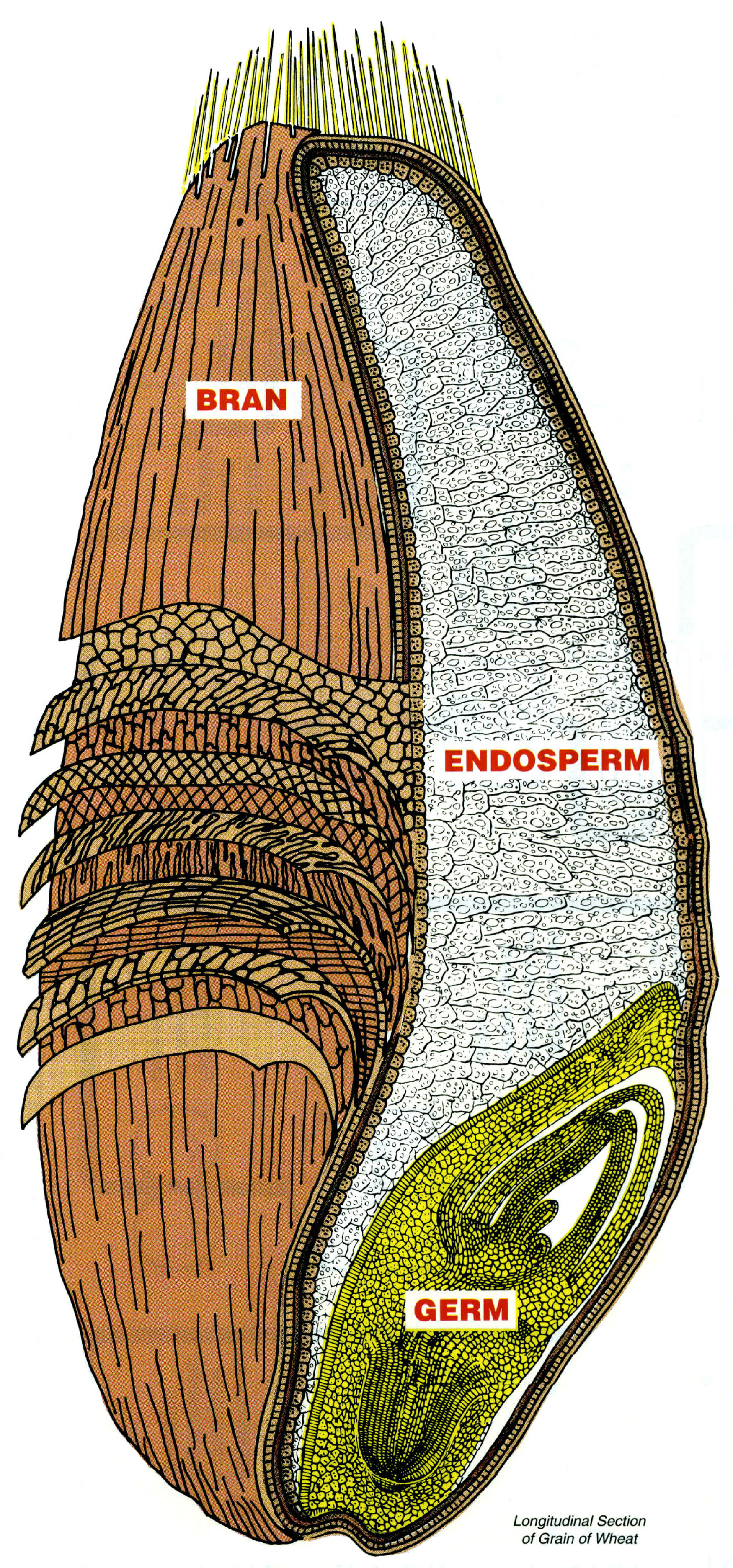
The wheat kernel (or wheat berry) has three components: the bran, the germ, and the endosperm. White flour that you purchase in the store is simply the endosperm. Actually, it would simplify so much if they called it “wheat starch” instead of “flour” so that you would know it was a kissing cousin to corn starch. The bran and germ sections have been sifted out, and are sold to you again as health supplements (or additives in healthy cereal, granola bars, salad toppings, etc.) or other value added products like animal feed. It is quite a racket: to sell the same thing to you three separate times.
The bran is the outer shell or wrapper consisting of 3 fibrous layers that protect the dormant nascent plant inside. These layers are rich in fiber and in minerals. One of these layers, the Aleurone layer, contains protein as well as high levels of vitamins and Phytic acid.
The germ is the embryo (remember, the grain is a seed of a plant), therefore it is high in both protein and fat, as well as containing the highest level of B vitamins. This is the engine inside the seed of the wheat kernel that will propel the new plant upwards. When the seed receives moisture and the plant starts to germinate, it is the germ that forms the new plant shoot.
The endosperm is all starch and protein. If the bran were to represent the fuselage and the germ the engine, the endosperm would be fuel for the new plant to start growing until it can metabolize sunlight on its own. When you buy enriched flour in the store, this what you are actually eating. It is the starch in the endosperm that contains gluten, giving baked products the composition to hold together.
A quick history of flour
The history of how white, deconstructed flour became “all the rage” is really quite fascinating. Basically, sifted flour was the European Royalty treat (think “corsets and fainting women”) and the robust peasants milled their own, hearty flours. Sifting (or boulting) has been a method employed since Roman times (they had seven grades of sifted flour). Sifting into “white” flour is nothing new, but it was never industrialized because the labor involved to go from raw wheat flour to refined sifted flour was so intensive.
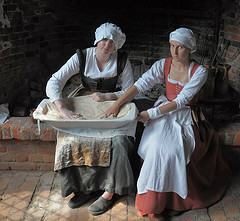
Enter the Industrial age—then an American figured out how to sift it commercially, and it became the thing in 1928. At about the same time, scientists discovered the causes of Pellagra, Scurvy and Rickets were deficiencies in niacin, vitamin C and D along with phosphorus respectively. The population at large was simply malnourished, and viola—“enrichment” became the Band-Aid® commonly practiced by 1938, and eventually the law in 1941. Flour enrichment was intended to bring ordinary flour back closer to whole wheat bread. This process is also credited with lowering the Pellagra rate from 10.5% in 1933 to only .5% by the year 1949. Even in recent history (the 2000’s), enrichment of folic acid became law and the number of babies born with neural tube defects decreased by 26%. Short version of the story, when you need to get some trace element out to the people, write a law and put it in the flour.
The Stripping and Enrichment Processes
So is whole wheat whole grain? No. It is very important understand that the greatest nutritional content of wheat is in the bran and germ, and that the endosperm—the stuff modern white bread is made of—does not contain the vitamins and minerals necessary for our daily diets. Modern day flour mills strip far more vitamins and minerals from the flour then they add back into it, and the enrichment is not sufficient to meet your body’s full dietary needs. Please do not misunderstand—adding some nutrition into dead flour has saved lives. But how many more could it save if the flour was served whole?
What is whole wheat? To answer that, please contrast the following two nutritional charts: the one on the left is for 1 serving of plain wheat berries (or kernels) and the one on the right is for a serving (1 slice) of store-bought white bread. When you compare them, understand that the 1 cup of wheat is simply 1 cup of the berries; your homemade bread, with honey, salt, liquid (potato water is full of nutritional benefits), and oil will have even higher levels.
Pure Wheat Berries: 1 serving of White Bread:
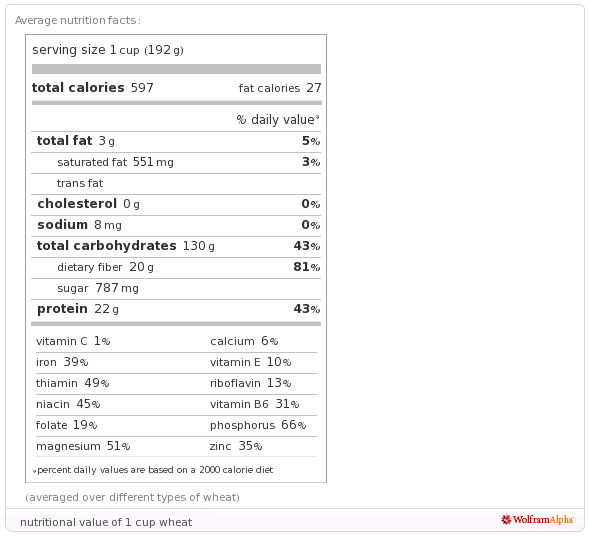
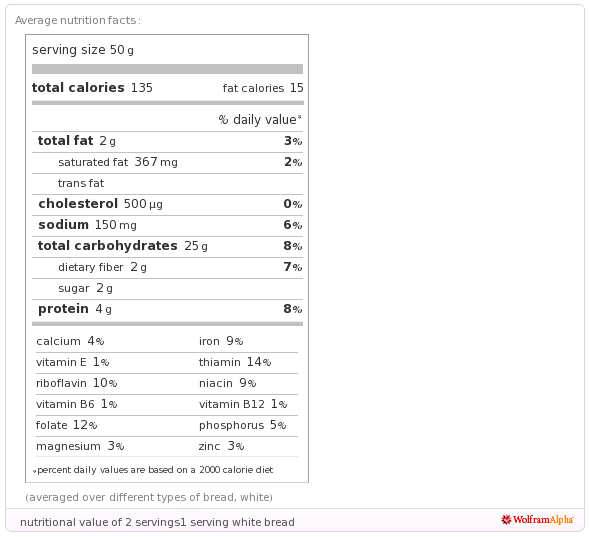
It is interesting to note that in the early 2000’s the law required the enrichment of flour with folate (folic acid). Although the quantities are different, look at the nutritional values again. Raw wheat berries and enriched bread are virtually the same amount of folic acid. There is no comparison between the fiber, iron, thiamin, niacin, magnesium, vitamin B6, phosphorus, and zinc!
There is something unique about the iron level differences between the raw and the processed. Anemia is the most widespread vitamin deficiency in the world, irrespective of the financial health of the countries. The white bread has been enriched with iron and cannot compare to the natural iron levels found within the wheat. Since there is more than one type of iron, and because the type naturally found within wheat oxidizes quickly, the enrichment process will insert a form less easily digestible than the one that comes integral to your wheat kernel. Actually, the iron in enriched flour “usually begins not only in iron ore mines in Minnesota, which is no surprise, but also in oil wells, which is” (Ettlinger, 2007). Ettlinger goes on to point out in hilarious detail that the ferrous sulphate (iron substitute) in enriched flour actually is derived from crude oil (sulphur) and the rust residue in acid pickling tanks from steel mills production lines (ferrous).
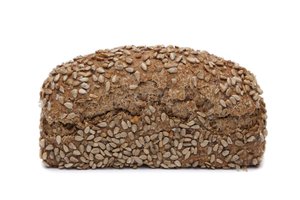
If flour mills take far more out than they put back in through enrichment—so why take it out at all? The reason is shelf stability. True whole wheat flour (flour made from all three parts of the wheat kernel) will quickly oxidize and go rancid. Actually, the nutritive value of the fresh ground whole wheat flour plummets in mere hours after it is ground (although the process can be stalled significantly if the whole wheat flour is immediately put into the freezer).
When flour mills strip the whole wheat grain of its bran and germ, they are taking more than the vitamins that you see on the label; they are stripping phytonutrients. Also called “phytochemicals,” these are plant nutrients that are not considered essential. That just means that they enhance your life but might not be essential to it. For instance, studies suggest that one such phytonutrient, Lignans, can guard against breast and prostate cancers (Mathis, 2005). These may not make a label, but they are crucial for quality of life.
“Let your food be your medicine and your medicine be your food” -Hippocrates.
To get quantity, there must be a bulk filler (typically starch) that is used to add nutrients back into the flour for enrichment. Remember that starch consists of high levels of glucose, and this turns quickly into a “sugar” in your body. So the enrichment process is not without the unfortunate side effect of making bread products “starchy” and a poor choice for diabetics. True living bread is not this way. The natural starches contained within the wheat are counterbalanced by the naturally occurring vitamins, minerals, fiber, and protein.
Vitamin E—The original miracle drug
Vitamin E is a fat soluble antioxidant. That means that they protect cells from harm done by damaging free radicals, which are molecules that contain an unshared electron (Office of Dietary Supplements, 2011). The Ohio State University measured the amount of vitamin E in various foods, to include oils. The highest item on the list was 1 tablespoon of wheat germ oil, just the oil! That one tablespoon provides 20.3 milligrams of vitamin E—that’s 135.3% of your RDA! There is no greater known source of Vitamin E in the world than in whole wheat (Mosure, 2004).
Phosphorus
Phosphorus along with Vitamin D are needed in healthy diets to fight Rickets (a disease where the bones degenerate and soften). Phosphorus is represented in adequate quantities in enough unprocessed foods so that deficiencies are only a concern in people who routinely consume antacids or who have a disease in the kidneys. Whole wheat is perhaps the second best common source for phosphorus you can find—the highest value going to the yeast used in bread baking. With the advent of enriched flour, the tracer bullet manufacturing sector has had to share its primary ingredient (Phosphorus) with bakers. Hmmmm, I think I will just stick to whole wheat home ground flour.
Conclusion
Let’s consider eating God’s bounty as He designed. We could discuss the various vitamins, minerals, and phytonutrients of whole wheat for many pages more; this is not an exhaustive list of the health benefits to this fundamental grain. Rather, it is a brief highlight of the value of this often underated food staple. Please consider replacing the deconstructed flour in your diet with true whole grain. Flour milling is as simple in modern times as flipping the switch on any kitchen appliance. The lingering scent of freshly baked bread, the indulgence of a warm slice from the oven, the improvement in skin, digestion, and overall health—this is a wonderful gift to yourself and to your family.
Chaya
Photo Credits:
Wheat kernel cutaway from the Montana Wheat and Barley Committee: http://wbc.agr.mt.gov/wbc/Consumer/Diagram_kernel/
Boulting Flour in the Bakehouse by Kentwell Hall Great Re-Creation, June 2010 (Depicting 1538) http://www.flickriver.com/photos/nigesphotobox/4741585459/
Bread by Viererie http://www.rgbstock.com/photo/nfAVg1Y/BreadBread
Works Cited:
Ettlinger, S. (2007). Twinkie, deconstructed, my journey to discover how the ingredients found in processed foods are grown, mined (yes, mined), and manipulated into what America eats. (First printing, March 2007 ed., Vol. 1, p. 32). London: Hudson st Pr.
Mathis MD, C. (2005, April 01). Web md. Retrieved from http://www.webmd.com/diet/phytonutrients-faq
Mosure, J. (2004, November). The Ohio State University Extension Office Online. Retrieved from http://ohioline.osu.edu/hyg-fact/5000/pdf/5554.pdf
Office of dietary supplements. (2011, October 11). Retrieved from http://ods.od.nih.gov/factsheets/VitaminE-HealthProfessional/
For further study:
http://www.drcranton.com/nutrition/bread.htm (highly recommended reading)
www.americanbakers.org, “Celebrating 70 years of Enrichment”
http://cuny.edu/archive/cc/health-in-america/nutrition.html
www.wolframalpha.com for the nutritional charts
http://www.mostproject.org/PDF/2.pdf US Aid, “Manual for Wheat Flour Fortification with Iron”
http://www.webmd.com/diet/phytonutrients-faq
http://www.lesliebeck.com/ingredient_index.php?featured_food=120 Leslie Beck, RD; “Wheat berries – March 2010’s Featured Food”
http://www.sph.emory.edu/wheatflour/KEYDOCS/MI_Fort_handbook.pdf Wesley and Ranum, eds. “The Fortification Handbook” (2004).
http://ohioline.osu.edu/hyg-fact/5000/5554.html Vitamin E: Ohio State University Extension Fact Sheet
http://ods.od.nih.gov/factsheets/vitamine/ Office of Dietary Supplements, National Institutes of Health. Dietary Supplement Fact Sheet: Vitamin E
Proviso:
Nothing in this blog constitutes medical advice. You should consult your own physician before making any dietary changes. Statements in this blog may or may not be congruent with current USDA or FDA guidance.
6 Comments
Becky
posted on Saturday, June 14, 2014 10:07:40 PM America/Denver
Marci
posted on Monday, October 6, 2014 9:49:08 AM America/Denver
Sharon
posted on Wednesday, October 8, 2014 1:11:34 AM America/Denver
Megan Stevens
posted on Monday, October 13, 2014 10:09:19 PM America/Denver
Hi Chaya, thank you so much for a wonderfully researched and insightful article!!! Two small things, you have “viola” up by/underneath the women sifting flour which is meant to be “voila.” I have done this myself and am always glad someone lets me know; so I hope you will not mind. Secondly, I think it would be helpful if you mention sourdough or sprouting, since the nutrients are much more accessible and historically-based as far as procedures and nutrition when the grain is predigested. Thanks, kindly, Megan 🙂
Thank you for catching that! I’ll change it right away; I want to get attribution correctly. You would enjoy this blog about Phytic Acid, in which I talk about there very thing! It would have made a good addition to this blog, agreed. It’s hard to fit so much science into a readable blog! Glad you liked the article.
JessMN
posted on Wednesday, October 15, 2014 7:11:47 PM America/Denver
Why do I even mention that? Because the author seems to have an axe to grind with faith and the Bible/Christianity in particular–which is altogether fine by me. My problem is that if I was anti-vegetarianism, I would not go take a shot at Seventh Day Adventists straw-man to gain traction on my argument. If following the evidence where ever it leads gets him to be upset with the nativity scene, then I think that my bias detector is correct when I see that as irrelevant to the topic at hand.
Back to wheat, yes, if he is correct, we eat a lesser form of wheat. By way of comparison, Chaya and I used to own a Boxer named Dallas. She was a GREAT dog, very affectionate, loyal, athletic and quite the clown. She was a Boxer; she was not a wolf. All dogs descended from wolves, she was a wolf-minus if you will, but we got all of the canine we needed in that lovable package. The point is to show a diminished modern product does not mean that what we have is somehow needs to be discarded because it is not pure. Sure, I would love to eat 42 chromosome wheat, and hopefully the author can bring the strain back to vogue and we can compare the data. But for now, the wheat we eat is very good, high in protein in Vitamin E.
To be clear, when I say “wheat” (as in what we eat at our house), we start out with a wheat berry/kernel and then grind that into flour. That wheat is superior to the bagels stacked as cover art of dead white flour that had to be enriched by law to avoid vitamin deficiencies like beriberi and rickets. In that the author and I are in agreement, that is not wheat, that is wheat starch-minus.
Thanks for the comment!
Wilson
Darryl C.
posted on Thursday, October 16, 2014 4:39:50 PM America/Denver

You really should compare the whole wheat berries to white flour and adjust for the same calories between the two. Otherwise the comparison is very uneven and set up for criticism.